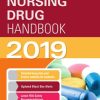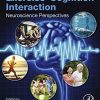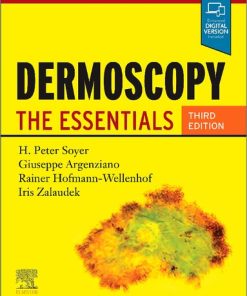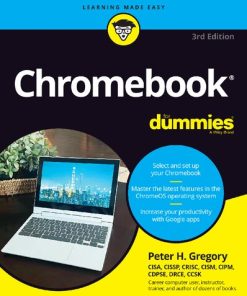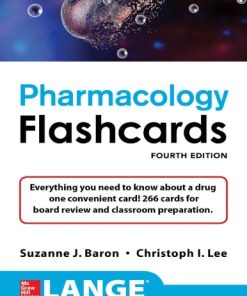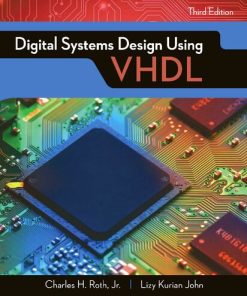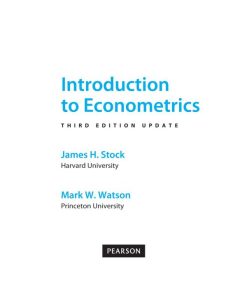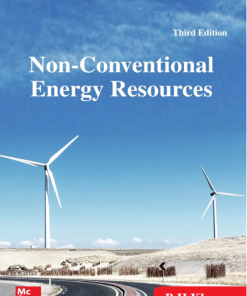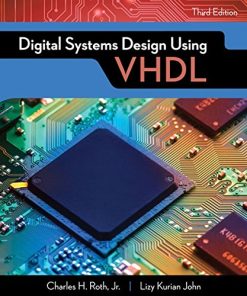(EBOOK PDF)ERCP 3rd Edition by Todd Baron 9780323527859 032352785X full chapters
$50.00 Original price was: $50.00.$25.00Current price is: $25.00.
ERCP 3rd Edition by Todd Baron – Ebook PDF Instant Download/Delivery: 9780323527859, 032352785X
Full download ERCP 3rd Edition after payment
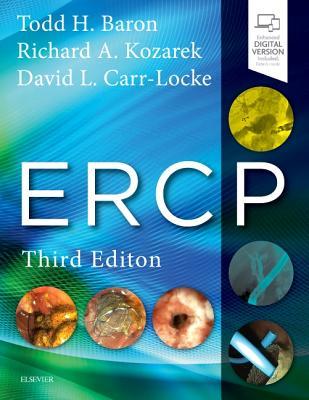
Product details:
• ISBN 10:032352785X
• ISBN 13:9780323527859
• Author:Todd Baron
ERCP
Over the past 40 years, ERCP has become an effective therapeutic modality with diagnostic purposes that are continually improved.. The 3rd Edition of this practical reference helps you make the most of today’s endoscopic retrograde cholangiopancreatography in your practice. You’ll find authoritative, highly illustrated guidance on every aspect of ERCP, including coverage of the latest techniques.
Clearly depicts each step of ERCP procedures in dozens of step-by-step videos, including Needle Knife Sphincterotomy, Biliary Sphincterotomy, Cannulation, and Fistulotomy.
Provides clear guidelines on when and when not to perform ERCP.
Features superb, full-color images, and a wealth of illustrative diagrams.
Includes new chapters that cover duodenoscope reprocessing; endomicrocopy; EUS-guided endotherapy related to pancreatobiliary disorders; and CT and MRCP related to pancreatobiliary disorders.
Contains updated information on radiofrequency ablation for cancer, percutaneous vs. endoscopic drainage, scope cleaning practices, and pancreatic necrosis.
ERCP 3rd Table of contents:
Instructions for online access
Cover image
Title Page
Table of Contents
Copyright
Dedication
Contributors
Foreword
Acknowledgment
Video Contents
Section I General Topics
1 Approaching 50 Years
ERCP in Its Infancy: 1968 to 1980
The Second Decade: 1980 to 1990
The Third Decade: 1990 to 2000
ERCP in the New Millennium
The Future of ERCP
Key Points
References
2 The ERCP Room
Evolution of the ERCP Room
Staffing for the ERCP Procedure
Room Layout
Radiologic Imaging Equipment
Room Integration Systems
Endoscopist Work Area
Preprocedure and Postprocedure Work Area
Anesthesia/Sedation Work Area
Nursing and Technician Work Area
Ergonomics
Miscellaneous Issues
References
3 Radiologic Issues and Radiation Safety During ERCP
Fluoroscopic Imaging Systems
Radiation Dose Management in Fluoroscopic Procedures
Occupational Ionizing Radiation Exposure
Creating and Viewing Images
Bile Duct Evaluation
Pancreatic Duct Evaluation
General Imaging Considerations
Additional Cancer Risks From Medical Radiation
References
4 Endoscopes, Guidewires, and Accessories
Endoscopes
Accessories
Accessories
Probe-Based Confocal Laser Endomicroscopy
Other Accessories
Role of the U.S. Food and Drug Administration in Device Evaluation and Monitoring
Radiation Exposure
References
5 Duodenoscope Reprocessing
Background
History of MDRO in Endoscopy
High-Level Disinfection and Reprocessing
Reaction From Regulatory Bodies
Strategies for Risk Reduction
Potential Solutions
Conclusions
References
6 Sedation in ERCP
Defining the Continuum of Sedation
Defining Sedation-Related Complications (Adverse Events)
Risk Assessment
Anesthesiologist-Administered Sedation
Nonanesthesiologist (Endoscopist)–Administered Sedation
Monitoring
Room Setup and Considerations for Safety
Conclusions
References
7 Indications for and Contraindications to ERCP
Indications for and Contraindications to ERCP
Indications for ERCP
Special Cases
Contraindications to ERCP
References
8 Adverse Events of ERCP
Definitions of Complications, Adverse Events, Unplanned Events, and Other Negative Outcomes
Analyses of Adverse Event Rates
Overall Adverse Events of ERCP and Sphincterotomy
Pancreatitis
Hemorrhage
Perforation
Cholangitis and Cholecystitis
Duodenoscope-Associated Bacterial Infections
Long-Term Adverse Events and Sequelae
Operator Experience and Adverse Events
References
9 ERCP Training
Training in ERCP
Current Status of ERCP Training
Learning Curves and Competence in ERCP
Toward Competency-Based Medical Education
ERCP Training Using Simulation
Maintenance of ERCP Skills and Volume for ERCP
Quality Measures for Trainees
Future Directions
Conclusions
References
Appendix 9.1 The EUS and ERCP Skills Assessment Tool (TEESAT)
10 Preparation of the Patient for ERCP
Should This Patient Undergo ERCP?
When, Where, and With Whom?
Evaluation of the Patient Before ERCP
Preparing the Patient: Day(s) Before ERCP
Method of Sedation, Proper Personnel, and Patient Monitoring
Preparing the Endoscopy Team
Preparing the Patient: the Day of the ERCP
References
11 Principles of Electrosurgery
Electrosurgery
A Brief History of Electrosurgery and ERCP
Basics of Electricity as Applied to Electrosurgery
Clinical Applications of Electrosurgery in ERCP
References
12 Quality Issues and Measures in ERCP
Preprocedure Quality Indicators
Intraprocedure Quality Indicators
Postprocedure Quality Indicators
Initiating Quality Measurements
Conclusions
References
13 Medicolegal Issues in ERCP
How Often Are Gastroenterologists Sued?
How Common Are Lawsuits Involving ERCP?
What Are the Key Legal Principles?
Standards of Care and Guidelines
Who May Be Liable? Not Only the ERCPist
Informed Consent
Why Do ERCP Lawsuits Occur?
How to Minimize the Risk of Litigation
When You Are Sued
Expert Testimony
A Summary of Recommendations
Conclusions
Acknowledgments
References
Section II Techniques
14 Cannulation of the Major Papilla
Establishing the Duodenal Position
Devices and Equipment for Cannulation (See Also Chapter 4)
Cannulation Technique
Difficult Cannulation
Needle-Knife Sphincterotomy (See Also Chapter 15)
Cannulation of the Pancreatic Duct
Quality and Enhancing Outcomes (See Also Chapter 12)
References
15 Access (Precut) Papillotomy
Indication for Precut Papillotomy
Precut Accessories
Techniques
Adverse Events (see Chapter 8)
Summary
References
16 Sphincter of Oddi Manometry
Method of SOM
Interpretation Criteria
Reproducibility of SOM
Adverse Events of SOM
Summary
References
17 Biliary Sphincterotomy
Description of the Technique
Indications
Contraindications
Adverse Events and Their Management (see Chapter 8)
References
18 Balloon Dilation of the Native and Postsphincterotomy Papilla
EPLBD After EST for Removal of Large Stones
Technique of Large-Balloon Dilation of Postsphincterotomy Papilla
Adverse Events of EPLBD After EST
EPLBD Without Preceding Sphincterotomy (EST)
Technique of EPLBD Without Sphincterotomy
Adverse Events of EPLBD Without EST
Recommendations for Safe and Successful EPLBD
EPBD of the Native Papilla
Indications for EPBD
Adverse Events of EPBD
Special Situations
Summary
References
19 Stone Extraction
Introduction and Scientific Basis
Biliary Stone Disease and Contraindications to ERCP (see Chapter 7)
DescriptionS of Techniques
Adverse Events and Their Management (see Chapter 8)
Relative Cost
Conclusions
References
20 Pancreatic Sphincterotomy
Endoscopic Pancreatic Sphincterotomy
Indications for Pancreatic Sphincterotomy
Adverse Events of Pancreatic Sphincterotomy
The Cost of Pancreatic Sphincterotomy
References
21 Minor Papilla Cannulation and Sphincterotomy
Indications for Minor Papilla Cannulation and Sphincterotomy
Sedation, Supplemental Drugs, and ERCP Accessories
Recognition of the Minor Papilla
Minor Papilla Cannulation (Video 21.1)
Cannulating the Minor Papilla in Difficult Cases
Minor Papilla Sphincterotomy
Pull-Type or Needle-Knife Sphincterotome: Pros and Cons
Precut Sphincterotomy in Case of Failed Dorsal Duct Cannulation
Postprocedural Stenting of the Minor Papilla
Repeat Minor Papilla Sphincterotomy
Outcomes of Minor Papilla Sphincterotomy
Adverse Events (See Chapter 8)
References
22 Plastic Pancreaticobiliary Stents and Nasopancreaticobiliary Tubes
Stent Systems
References
23 Biliary Metal Stent Insertion
Indications
Description of Technique
Adverse Events and Their Management
Relative Cost
References
24 Pancreaticobiliary Stent Retrieval
Removal of Biliary Stents
Removal of Pancreatic Stents
Removal of Lumen-Apposing Metal Stents
Summary
References
25 Papillectomy and Ampullectomy
Treatment Options
Considerations in FAP
Technique (Box 25.1)
Indications and Contraindications (Box 25.2)
Adverse Events and Their Management (Boxes 25.3 and 25.4)
Success
Relative Cost Savings
Subepithelial Lesions
Summary
References
26 Pancreatoscopy
Equipment and Technique
Diagnostic Indications
Therapeutic Indications
Adverse Events and Management
Relative Cost
Conclusions
References
27 Cholangioscopy
Single-Operator Cholangioscopy
Videocholangioscopy Using the Mother–Baby System
Videocholangioscopy by the Direct Insertion System
Acknowledgment
References
28 Endomicroscopy in the Pancreaticobiliary Tree
Confocal Laser Endomicroscopy
Technique
Diagnostic and Safety Data
Optical Coherence Tomography
Conclusion
References
29 ERCP in Children
Description of Technique
Indications and Contraindications (Box 29.1)
Adverse Events
Relative Costs
References
30 ERCP in Pregnancy
Indication
Diagnostic Imaging Modalities
Timing
Radiation Exposure During ERCP (see Chapter 3)
Strategies to Minimize Radiation Risk to the Fetus
Positioning, Sedation, and Medications
Techniques
Outcomes After ERCP During Pregnancy
Conclusions
References
31 ERCP in Surgically Altered Anatomy
Surgery That May Affect the Performance or Interpretation of ERCP
Esophageal Resection
Gastric Resection
Upper GI Bypass Surgery Without Resection
Bariatric Surgery
Pancreatic Resection
Pancreatic Duct Drainage Procedures
Biliary Surgery
Endoscopic Techniques Commonly Employed for ERCP in Surgically Altered Anatomy
ERCP Accessories
Conclusions
References
32 Endoscopic Ultrasonography–Guided Biliary Drainage
Description of Technique
Indications and Contraindications
Procedural Outcomes and Adverse Events
References
33 Endoscopic Ultrasound and EUS-Guided Endotherapy
Overview
Endoscopic Ultrasonography
Celiac Nerve Block and Neurolysis
Drainage of Pancreatic Fluid Collections
Pancreatic Duct Access and Drainage
Biliary Drainage
Gallbladder Drainage
EUS-Guided Ablation and Cancer Therapy
Conclusions
References
Section III Approach to Clinical Problems
34 Pancreaticobiliary Disorders
Role of Noninvasive Imaging and EUS Compared With ERCP in Benign Hepatobiliary Diseases
Suspected Pancreaticobiliary Malignancy
Conclusions
References
35 Pancreas Divisum, Biliary Cysts, and Other Congenital Anomalies
Ampullary Anomalies
Biliary Anomalies
Pancreatic Anomalies
References
36 Dilated Bile Duct and Pneumobilia
Dilated Bile Duct
Pneumobilia
References
37 The Dilated Pancreatic Duct
Background and Definitions
Evaluation
Treatment
Conclusions
References
38 Ampullary Neoplasia
Symptoms and Signs
Diagnostic Workup and Evaluation
Pathology
Treatment
Conclusions
References
39 Malignant Biliary Obstruction
Epidemiology
Natural History
Clinical Features and Initial Evaluation
Differential Diagnosis of Distal Biliary Malignancies and Imaging Techniques
An Approach to the Management of Patients With Distal Biliary Malignancies
Summary
References
40 Malignant Biliary Obstruction of the Hilum and Proximal Bile Ducts
Cholangiocarcinoma
Anatomy of the Bile Ducts
Diagnostic Evaluation
Management
Conclusions
Acknowledgments
References
41 Indeterminate Biliary Stricture
Historical Features
Laboratory Features
Noninvasive Cross-Sectional Imaging
Invasive Imaging Techniques
Tissue Acquisition and Pathologic Investigations
Ancillary Techniques
References
42 Endoscopic Approaches to Concomitant Malignant Biliary Obstruction and Gastric Outlet Obstruction
Anatomic and Clinical Scenarios
Results
EUS-Guided Gastroenterostomy
Conclusions
References
43 Benign Biliary Strictures
Clinical Features and Diagnosis
Endoscopic Technique
Outcomes of Endotherapy
Conclusions
References
44 Biliary Surgery Adverse Events, Including Liver Transplantation
Laparoscopic Cholecystectomy
Liver Resection
Liver Transplantation
Living-Related-Donor Transplants
Summary
References
45 ERCP and EUS for Acute and Chronic Adverse Events of Pancreatic Surgery and Pancreatic Trauma
Pancreaticoduodenectomy (Whipple Operation) With and Without Pylorus Preservation
Biliary Obstruction
Distal and Central Pancreatectomy
Puestow or Longitudinal Pancreatojejunostomy
Enucleation
Summary
References
46 Choledocholithiasis
Evaluation of Patients With Suspected Choledocholithiasis
Extraction of Bile Duct Stones (see Chapter 19)
Difficult Bile Duct Stones
Conclusions
References
47 Pancreaticobiliary Pain and Suspected Sphincter of Oddi Dysfunction
Definitions
Clinical Evaluation in Patients With Suspected SOD
Upper Abdominal Pain With Gallbladder in situ
Informed Consent for ERCP for Suspected SOD
Sphincter of Oddi Manometry: Equipment and Technique (see Chapter 16)
Treatment of SOD
Prevention of Post-ERCP Pancreatitis
Evaluation of Patients With Recurrent Pain After Endoscopic Intervention for Sphincter of Oddi Dysfunction
Conclusions
References
48 Sclerosing Cholangitis
Background
Diagnosis and Natural History
Endoscopic Treatment
Cholangiocarcinoma
References
49 Tropical Parasitic Infestations
Ascaris lumbricoides
Echinococcus granulosus
Clonorchis sinensis
Fasciola hepatica
Summary
References
50 Recurrent Pyogenic Cholangitis
Introduction and Scientific Basis
Initial Management of Patients With Cholangitis
Specific Treatment of Intrahepatic Stones
Indications and Contraindications
Adverse Events and Their Management
Long-Term Management of RPC
Surgery
Relative Cost
References
51 Cystic Lesions of the Pancreas
Prevalence
Clinical Epidemiology
Risk Factors for Cystic Lesions
Pathogenesis
Pathology
Clinical Presentation
Differential Diagnosis
Diagnostic Methods
Diagnostic Evaluation
Treatment
Prognosis
References
52 Unexplained Acute Pancreatitis and Acute Recurrent Pancreatitis
Pathophysiology and Role of ERCP, EUS, and MRCP
Diagnostic Findings and Timing of ERCP, EUS, and MRCP
Occult Gallstone Disease
Sphincter of Oddi Dysfunction (See Chapter 47)
Differences in Defining Study Outcomes
Pancreas Divisum
Choledochocele
Tumors
Other Anatomic Causes
Genetic Mutations
Autoimmune Pancreatitis
Yield of ERCP, MRCP, and EUS for IAP and IARP
Outcomes of Endoscopic Therapy in IARP
Conclusions
References
53 Biliary Intervention in Acute Gallstone Pancreatitis
Diagnosis of Acute Gallstone Pancreatitis
Prediction of Common Bile Duct Stones
Assessment of Severity of Acute Pancreatitis
Treatment of Acute Gallstone Pancreatitis
Role of MRCP Versus Endoscopic Ultrasonography
Emerging Evidence: Pancreatic Duct Stent Placement
Algorithm for the Management of Acute Gallstone Pancreatitis
Miscellaneous Issues
References
54 Pancreatic Interventions in Acute Pancreatitis
Background
Epidemiology of Ductal Disruption
Classification
Management Strategies (Box 54.4)
Management (Box 54.6)
Adverse Events (Box 54.7) (see Chapter 8)
Summary
References
55 Chronic Pancreatitis
Endoscopic Treatment: Ductal Decompression by Managing Stones and Strictures
Summary
References
56 Endoscopic Drainage of Pancreatic Pseudocysts, Abscesses, and Walled-Off (Organized) Necrosis
Specific Types of Fluid Collections
Collections Composed Entirely or Predominantly of Liquid
Indications for Drainage of Liquefied Collections
Predrainage Evaluation
Drainage Techniques
Pancreatic Necrosis
Results of Endoscopic Therapy of Pancreatic Fluid Collections
Outcome Differences After Endoscopic Drainage of Pancreatic Fluid Collections
Role of Endoscopic Experience
Adverse Events of Endoscopic Therapy of Pancreatic Fluid Collections
References
Index
Read More
People also search for ERCP 3rd:
ercp 3rd edition todd h baron
ercp todd baron
ercp baron
todd h baron
todd baron ercp
Tags:
ERCP 3rd,ERCP,Todd Baron
You may also like…
Computers - Hardware
Computers - Hardware
Digital Systems Design Using VHDL 3rd Edition Charles H. Roth
Business & Economics - Mathematical Economics
Technique - Energy: Renewable Energy
Computers - Hardware
Digital Systems Design Using VHDL 3rd Edition Charles H. Roth


